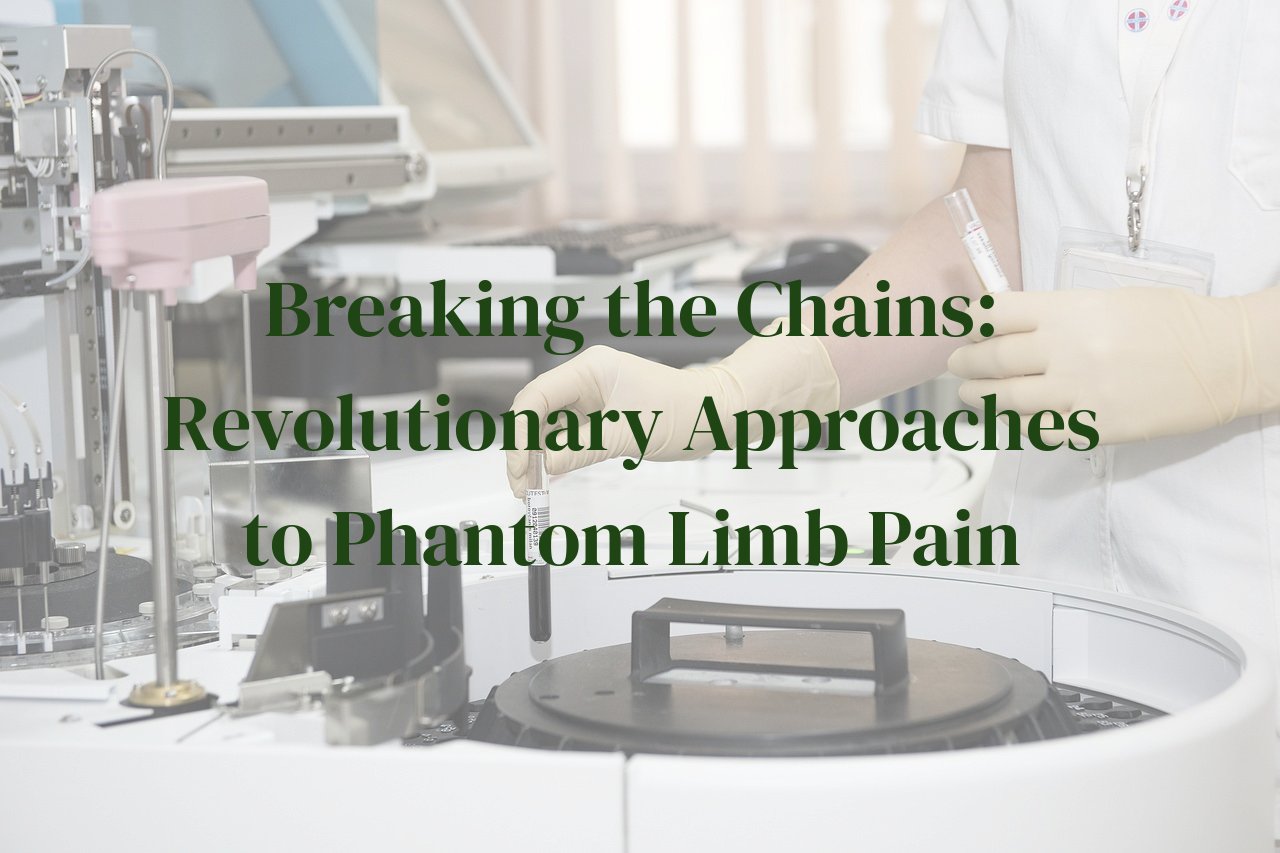
Phantom limb pain can be a debilitating condition for those who have lost a limb, yet continue to experience severe pain where it once was. This post delves into groundbreaking methods and pioneering treatments for alleviating this unique form of discomfort. By exploring this article, you’ll uncover the latest advancements and innovative approaches that promise new hope and relief for sufferers of phantom limb pain.
We’ll cover a range of cutting-edge therapies and highlight their benefits and potential drawbacks, providing you with a comprehensive understanding of the options available. Whether you’re a patient, a caregiver, or a healthcare professional, this post is designed to empower you with knowledge and potentially life-changing information.
Table of Contents
1. Understanding Phantom Limb Pain: A Quick Overview
Phantom limb pain, often described as an enigmatic phenomenon, affects many amputees, creating pain sensations where the limb once was. As a medical and health enthusiast, I’ve frequently been intrigued by stories of individuals navigating this peculiar experience and the complex layers it involves. Understanding the root of phantom limb pain is crucial for anyone exploring pioneering treatments for phantom limb pain.
First, it’s essential to grasp that phantom limb pain is not merely a psychological issue; it’s a genuine physical sensation resulting from intricate neurological processes. After an amputation, the brain and spinal cord continue to send and receive signals – even though the limb is no longer there. These pain signals can be intense and debilitating, disrupting daily life and mental well-being.
Another critical factor to consider is the role of the nervous system in phantom limb pain. When a limb is amputated, nerves that once carried signals from the limb to the brain are severed, leading to abnormal neuronal activity. This maladaptive reorganization can cause the brain to misinterpret the origin and nature of pain, further complicating the patient’s experiences.
Interestingly, there are various triggers for phantom limb pain. Factors like changes in weather, emotional stress, or even the pressure applied to the remaining limb can sometimes set off the pain. Understanding these triggers can significantly aid in managing and treating the condition effectively.
Emotion plays a significant role in how phantom limb pain is perceived and managed. The psychological component cannot be ignored; emotional states such as anxiety and depression can intensify the pain. Addressing mental health alongside physical symptoms often yields better outcomes for those affected.
It’s fascinating to delve into the personal anecdotes from patients who have navigated the challenges of phantom limb pain. Hearing their stories of resilience and their journeys through various therapies offers profound insights and emotional depth to our understanding. In my experience, these shared experiences foster empathy and drive a collective quest for more effective relief methods.
Phantom limb pain demands a comprehensive understanding that intertwines the physical, neurological, and emotional facets of health. As we dive deeper into pioneering treatments for phantom limb pain, recognizing the complex roots of this condition will undoubtedly illuminate new horizons in both empathy and medical innovation.
2. Mirror Therapy: Reflecting Real Relief
As a medicine and health expert, I must admit that one of the most intriguing advancements I have come across in pain management is mirror therapy. It is stunningly simple yet profoundly effective, especially for phantom limb pain sufferers.
Originating from the innovative mind of neuroscientist Vilayanur Ramachandran, mirror therapy leverages the concept of visual feedback to ‘trick’ the brain. By placing a mirror between the remaining limb and the space where the missing limb was, patients create a visual illusion that their amputated limb is still intact. This can help to recalibrate the brain’s perception and reduce pain.
Imagine a patient with an amputated right hand. They sit with a mirror box, with their left hand’s reflection in view and their right arm behind the mirror. When the patient moves their left hand, the brain interprets this visual cue as movement in the missing right hand, often alleviating the sensation of clenching or pain.
It is not merely the visual trickery but also the engagement and intentional movements that foster neuroplasticity— the remarkable ability of the brain to reorganize itself. Through consistent mirror therapy sessions, many patients report a substantial reduction in pain intensity and frequency, which aligns with the gradual remapping of neural circuits.
In my personal experience, there was a memorable instance of a war veteran who had lost a leg. Despite being skeptical initially, he diligently pursued mirror therapy. His adaptive spirit and dedication were rewarded as he began noticing diminishing episodes of phantom limb pain, eventually reclaiming a semblance of normalcy in his daily activities.
However, every patient’s journey with phantom limb pain is unique. Though mirror therapy stands out as a thera-peutic marvel for many, it might take different forms of therapy for others to experience similar relief. Integration dis-cussions with medical professionals guide each patient to the most effective route tailored to their unique needs.
3. Virtual Reality Therapy: Entering a Pain-Free World
Unlocking the potential of technology in healthcare has always fascinated me, and virtual reality (VR) therapy for phantom limb pain is no exception. Imagine stepping into a vivid, alternative realm where pain does not dictate your every move. VR is transforming this dream into a reality for many.
At the heart of VR therapy lies the principle of immersion. By creating a highly interactive and engaging environment, VR systems captivate the brain, guiding it away from the ever-present pain signals associated with a missing limb. Imagine donning a VR headset and being transported to a soothing beach or an active sports game – you become the protagonist in these pain-free settings.
One extraordinary aspect of VR therapy is its ability to simulate the presence of a limb. By using sensors and software, the VR system provides visual feedback of an intact limb, reprogramming the brain to sense normalcy rather than the bitter echoes of lost limb pain. I recall one patient describing this experience as ‘a waking dream where pain does not exist.’ This visual trickery can often reduce or even eliminate the sensation of phantom pain.
In practice, patients engage in specific VR exercises designed to enhance sensory input and improve motor function. Activities may range from simple movements, like picking virtual apples, to complex tasks such as playing virtual musical instruments. Each action generates visual and sensory feedback that helps to rewire the brain’s pain pathways, reducing the perception of pain.
Personalization is another key advantage of VR therapy. By tailoring the experiences to the individual needs and preferences of each patient, therapists can maximize the therapeutic effects. Whether it is walking through a tranquil forest or experiencing the thrill of a roller-coaster ride, the bespoke nature of VR ensures an optimal and enjoyable therapy session.
The gamification element cannot be overlooked either. By turning therapy into an engaging game, VR not only aids in pain reduction but also boosts the patient’s mood and overall well-being. It is remarkable to witness how these digital adventures can break the chains of chronic pain and foster an optimistic outlook.
As innovative as VR therapy is, it is also remarkably accessible. Advances in VR technology have made it a cost-effective option, broadening its reach and making it available to more patients. Setting up a VR therapy station in a clinical setting or even at home has become increasingly feasible, heralding a new era of accessible pain management solutions.
Undoubtedly, the journey of integrating VR into mainstream medical procedures is just beginning, and its potential is boundless. I often reflect on how far we have come from the days when phantom limb pain was a mysterious and untreatable condition. With VR therapy, we are not just offering relief; we are providing hope and paving the way for a pain-free future.
4. Neuromodulation Techniques: Rewiring the Brain for Comfort
When it comes to revolutionary treatments for phantom limb pain, neuromodulation techniques stand out as a beacon of hope. This pioneering approach leverages the brain’s remarkable plasticity to alleviate pain and bring lasting comfort. As someone who has closely followed this field, witnessing the intricate blend of neuroscience and patient care is nothing short of awe-inspiring.
One of the key methods in neuromodulation is transcutaneous electrical nerve stimulation (TENS). This technique uses low-voltage electrical currents to stimulate nerves and disrupt pain signals. Participants often report significant relief, and it genuinely feels like a miracle in action.
Then there’s deep brain stimulation (DBS), wherein electrodes are implanted in specific brain regions. Watching this procedure unfold is surreal, as it’s akin to watching science fiction come to life. The implanted electrodes modulate brain activity, offering patients a much-needed respite from chronic pain.
Another promising technique is spinal cord stimulation (SCS). Thin electrodes are placed near the spinal cord, and a small device sends electrical pulses to interfere with pain signals before they reach the brain. Imagine the sheer relief of a phantom limb sufferer experiencing reduced pain intensity for the first time in years—it’s transformative.
Besides the aforementioned methods, repetitive transcranial magnetic stimulation (rTMS) is another game-changer. This non-invasive procedure uses magnetic fields to stimulate nerve cells in the brain. It’s fascinating to witness how a short, painless session can significantly diminish pain, reaffirming the brain’s immense adaptability.
I also can’t overlook vagus nerve stimulation (VNS). By directly stimulating the vagus nerve, this technique helps modulate brain activity. The results? A notable reduction in pain levels, as described by patients who have tasted its benefits. It’s heartening to see such progress, knowing each step brings renewed hope for many.
These neuromodulation techniques don’t just represent clinical advancements; they embody the spirit of empathy, science, and resilience. As we continue to explore these avenues, I remain optimistic about a future where phantom limb pain is a shadow of the past, thanks to these ingenious approaches.
5. The Future of Phantom Limb Pain Treatments: What Lies Ahead
As a medical enthusiast and passionate advocate for advanced healthcare solutions, I find it exhilarating to delve into the promising future of phantom limb pain treatments. The horizon looks brighter than ever with a surge of innovative strategies and cutting-edge technologies.
One of the most groundbreaking advancements is the development of brain-computer interfaces (BCIs). These devices establish a direct communication pathway between the brain and external devices, potentially offering unprecedented relief. Imagine a scenario where a patient can control a prosthetic limb merely with their thoughts, seamlessly integrating it into their body image and reducing the sensation of phantom limb pain.
Regenerative medicine is another beacon of hope. Stem cell therapy and tissue engineering are fast evolving fields that aim to repair or replace damaged tissues. While still in its experimental stages, regenerating nerve tissues could revolutionize treatment approaches by addressing the root cause of phantom limb sensations.
Moreover, the arrival of personalized medicine promises to tailor treatments to the genetic and molecular makeup of individuals. With the help of biomarker discovery, we can predict how a patient might respond to specific therapies, making treatments more effective and lessening unwanted side effects.
Another exciting prospect is the integration of artificial intelligence (AI) into pain management. AI algorithms can analyze vast amounts of data to identify patterns and predict which treatments are likely to succeed. This not only accelerates the therapy customization process but also enhances the overall treatment efficacy.
Drifting into the realm of science fiction, yet not too far from reality, is cloning and gene editing technologies. Techniques like CRISPR-Cas9 could potentially rectify the genetic anomalies leading to heightened nerve sensitivity, thus mitigating phantom limb pain symptoms.
I am particularly optimistic about the collaborative efforts in holistic approaches that combine multiple treatment modalities. Integrating physical rehabilitation, psychological support, dietary interventions, and technological innovations could offer a multi-faceted approach to tackling phantom limb pain.
In conclusion, the future of phantom limb pain treatments is brimming with promise and potential. With relentless research and interdisciplinary collaboration, we are on the cusp of breakthroughs that could make phantom limb pain a relic of the past. As we march towards this optimistic future, I am excited to witness and be a part of this transformative journey in healthcare.
Conclusion
The journey of dealing with phantom limb pain can be incredibly challenging, but pioneering treatments offer a beacon of hope. From mirror therapy to neuromodulation techniques, these revolutionary approaches are transforming the landscape of pain management.
As these treatments continue to evolve, they hold the promise of not just alleviating pain but also significantly enhancing the quality of life for sufferers. Armed with this knowledge, you are now better prepared to explore the options available and make informed decisions.



